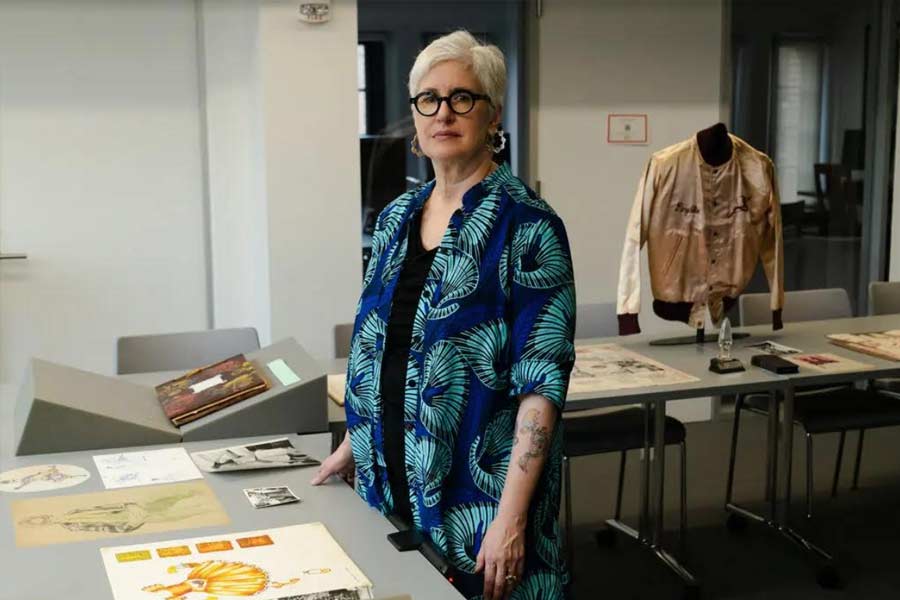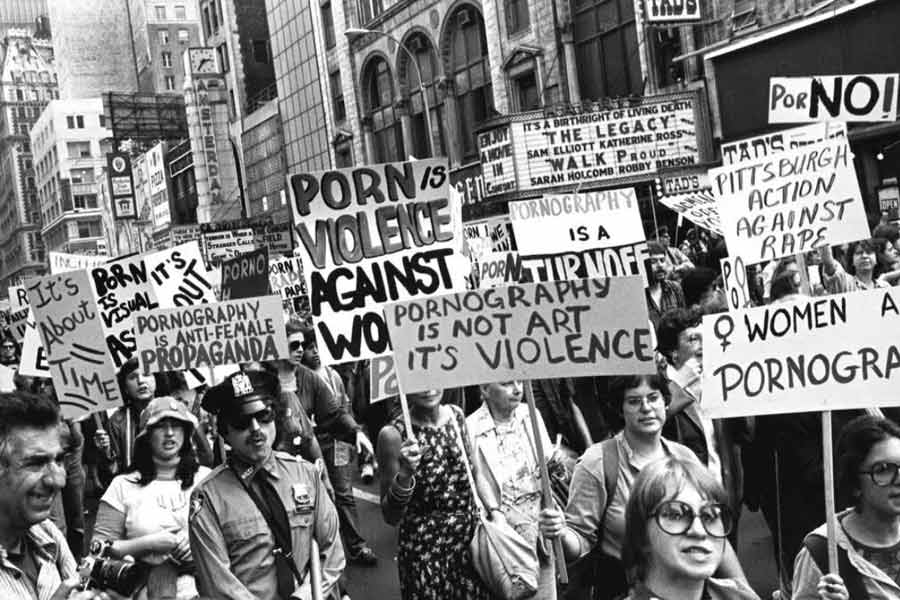Harvard University’s Schlesinger Library is the nation’s leading repository for women’s history, home to the papers of suffragists and social reformers, poets and politicians, the collective behind “Our Bodies, Ourselves” and iconic figures including Amelia Earhart, Angela Davis and Julia Child.
But in its basement vaults, carefully preserved in a box, you can also find a rather different artifact: a costume from the 1978 pornographic comedy “Hot & Saucy Pizza Girls.”
The movie, starring John C. Holmes as a pimp who oversees a prostitution ring masquerading as a pizza delivery service, was history-making in its own way, as one of the earliest examples of what became a classic trope — porn with pepperoni. But the costume is at the Schlesinger because of another name on the bill: Candida Royalle.
Royalle, who died in 2015, was a minor celebrity in her day. She was a porn star from the 1970s golden age who moved to the other side of the camera, producing feminist erotica that focused on female fantasies, and female audiences.
During the so-called sex wars of the 1980s, Royalle faced off against anti-porn feminists such as Andrea Dworkin and Catharine MacKinnon, who dismissed women in the profession as stooges of the patriarchy. And in the 1990s, she became a godmother to the mediagenic sex-positive feminists riding feminism’s third wave.
Today, Royalle’s name may ring a few bells. But her voluminous archive is now housed at Harvard, where the trove of diaries, letters, photographs, scrapbooks, videos and memorabilia is opening up a new window onto the sexual revolution.

The historian Jane Kamensky, with items from Royalle’s voluminous personal archive, which is now held at Harvard’s Schlesinger Library.
That is the argument made by Jane Kamensky, the historian who spearheaded the acquisition of Royalle’s papers. In the new biography “Candida Royalle and the Sexual Revolution: A History From Below,” Kamensky puts Royalle at the center of an ambitious, ambivalent history that aims to unsettle any idea of a conflict with firm battle lines.
“She is way too critical and self-critical for many of the sex-positive feminists,” Kamensky said. “And she absolutely does not fit into an anti-pornography box.”
Royalle’s story, Kamensky said, “shows us that we have the wrong boxes.”
Kamensky, a leading scholar of the American Revolution who recently left Harvard to become president of Thomas Jefferson’s Monticello, is not the person you would expect to write the biography of a conflicted late-20th-century porn queen.
But the sexual revolution may not be wholly different from that 18th-century political struggle, which divided would-be Americans against each other — and within themselves — far more than we remember today.
“It’s a struggle of ideas, but also a struggle with people’s bodies on the line,” Kamensky said. “And every gain is alloyed with loss.”
‘Is There an Archive?’
In the 1990s, as a vogue for porn studies swept some corners of the humanities, Royalle made appearances on college campuses, marveling at her climb “from slut-drug addict to politically correct successful entrepreneur spokeswoman for women’s sexuality,” as she wrote in her diary.
Still, when Kamensky came across her obituary in September 2015, she had never heard of Royalle. Kamensky was a few weeks into a new job as faculty director at the Schlesinger, with an eye toward expanding its holdings beyond its predominantly upper-middle-class, liberal, educated, “Acela corridor” purview, as she put it. Reading about Royalle, she wondered, “Is there an archive?”
Two months later, Kamensky was passing out business cards at Royalle’s memorial in New York, where hundreds of guests paid tribute and snacked on cherry tomatoes from her garden.

A 1979 protest in Times Square by the group Women Against Pornography. Anti-porn feminists argued that women in the sex industry were victims or dupes.
Royalle’s executor was Veronica Vera, a Wall Street trader turned journalist (and sometime Robert Mapplethorpe model), who, since 1989, has run a downtown Manhattan outfit called Miss Vera’s Finishing School for Boys Who Want to Be Girls. She had become close with Royalle in 1983, after a baby shower where she and a group of other women in the sex industry, including Annie Sprinkle, Veronica Hart and Gloria Leonard, shut down the party dancing together to “West Side Story.”
They started meeting regularly as Club 90 (named after Sprinkle’s street address), sometimes described as the first porn star support group, which also staged self-aware performances at downtown arts spaces. And when Royalle fell ill with ovarian cancer, they rallied to tend her and her legacy.
When the Schlesinger came calling, Vera asked why the library wanted the archive. Kamensky explained that it already had the papers of Dworkin, MacKinnon and the group Women Against Pornography, and wanted “the other side.”
“That was very meaningful to me,” Vera said. “For so long, it’s always the anti-porns that get quoted and the people that actually work in the industry are left out.”
Dreams of Being Famous
One morning last December, the library’s curator for gender and society, Jenny Gotwals, and a senior archivist, Mark Vassar, had laid out a sampling of the archive.
There was no loose glitter and no pizza, saucy or otherwise. But there was a mannequin in a staff jacket from High Society, the pornographic magazine for which Royalle was a columnist in the 1980s, and a suggestively shaped award trophy for “Hottest Group Sex Scene.”

Royalle’s first diary, begun on New Year’s Day, 1962, when she was 11.

The archive includes journals she kept nearly continuously for more than 40 years.
But mostly, the tables were covered with diaries, letters, scrapbooks, photographs and ephemera that Royalle — “a budding archivist” even as a child, Kamensky writes — had carefully preserved.
Royalle was born Candice Vadala in 1950 into a Catholic working-class family on Long Island. Her father, Louis, was a professional jazz drummer who was given to rages. When Candice was 2, her mother left the family. Candice never saw her again.
Louis remarried, and the family eventually settled in the Bronx, where Candice started her first diary on New Year’s Day, 1962.
The small red leatherette volume, complete with flimsy brass lock, is full of entries about girlish crushes and family fights, usually illustrated with a drawing of her outfit that day. But in an entry from September 1963, she describes a sexual assault in a park near the family apartment, accompanied by another drawing.

A photocollage from one of Royalle’s scrapbooks, from the 1970s.
Archival ethics can be tricky, even when there’s no sex involved. How much right does a researcher have to publish the most intimate and traumatic details of people’s lives?
Writing during her final illness, Royalle wondered if her journals and photographs would “end up in junk stores & flea markets,” where strangers would “paw at my memories without even knowing my name.” But it wasn’t a “burn this” moment, Kamensky said.
“I think she feels deep ambivalence about parts of her work and her world,” Kamensky said. “And yet she documented it.”
Vera, who is currently preparing her own archive to send to the Schlesinger, agreed. The diaries “seemed to be written with the idea that someone was going to read them later,” Vera said. “There was this idea she was going to be famous.”

An Easter-themed collage in the archive.

A drawing from Royalle’s San Francisco years.
As a girl, Royalle studied ballet and dreamed of being a “famous dancer,” as she wrote at age 11, in a letter to her future self, titled “My Secret Desires.” In 1972, after leaving the City College of New York, she went to San Francisco, where she worked odd jobs and performed with avant-garde troupes like the Angels of Light, an offshoot of the anarchic drag collective the Cockettes.
Kamensky’s account of Royalle’s years in Los Angeles, where she moved in 1976 hoping to break into “real” acting, evokes the rollicking golden age of porn captured in the movie “Boogie Nights.” She had a brief appearance in an orgy scene in Blake Edwards’ “10,” where she was credited as “third female sex performer.” But mostly she made porn, ultimately appearing in nearly 50 films.
Her diary entries from those years are edged with both pleasure in her beauty and power and despair at feeling stuck. During a 1980 tour of strip clubs, she wrote: “Each time I know I have to go onstage soon I feel like screaming and crying.”
That year, Royalle and her new husband, the son of a Swedish pornography producer, moved to New York, where she started writing for the booming sex press, sometimes critiquing the sexist clichés of hard-core pornography. In 1984, she and Lauren Niemi founded Femme Productions, with the goal of making woman-centered films intended for couples, who could now watch porn from the intimacy of the bedroom, thanks to the VCR. Femme’s first release did not include a single “external male orgasm,” as Kamensky puts it.
The venture put Royalle in collision with the rising anti-porn feminists, who had allied with conservative politicians. Kamensky describes a chaotic 1985 episode of “Donahue,” where Royalle and other pro-sex feminists debated MacKinnon, who icily declared that their attempts at enlightened pornography had “failed.”
The V-Word
There are many unprintable words in Kamensky’s book, but few as charged as the V-word: victim.
For anti-porn campaigners, women in the sex industry were victims of brainwashing, or worse. MacKinnon, a lawyer, at one point represented Linda Lovelace, the star of “Deep Throat,” who said that her husband had forced her to appear in the film at gunpoint.
Kamensky describes how one of Royalle’s friends suggested she call the biography “From Victim to Victor.” But in truth, Kamensky writes, “she was always both.”

Royalle kept a journal nearly continuously for 40 years. “Still trying to unlock the key to myself,” she wrote in 2013, two years before her death.
The New York Times News Service










